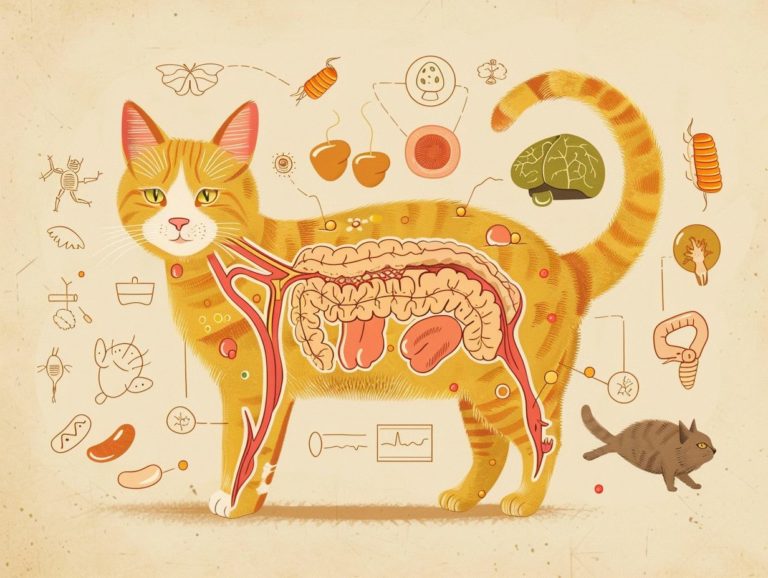Managing Arthritis In Older Cats Tips And Treatments
Arthritis is a common condition that affects older cats, causing pain and inflammation in their joints. This guide will explore the causes and symptoms of arthritis in cats, diagnostic techniques for detection, and the various treatment options available, including medications, therapies, and alternative treatments.
Additionally, we will provide tips and recommendations for managing arthritis in cats at home, as well as preventive measures to help maintain the health and mobility of your feline companion.
Key Takeaways:
Understanding Arthritis in Older Cats
Understanding Arthritis in Older Cats is crucial for ensuring proper treatment and care for aging felines. Arthritis is a joint disease that causes pain and reduced mobility in cats, common symptoms of aging in felines. Cat owners should be familiar with signs of arthritis in their senior cats to identify the condition. Symptoms like stiffness, reluctance to jump, decreased activity levels, and changes in grooming habits may indicate arthritis in older cats.
Osteoarthritis is the most prevalent type of arthritis in cats, diagnosed by a veterinarian through physical examination and imaging tests like x-rays. Pain management medications, joint supplements, physical therapy, weight management, and other treatments significantly enhance the comfort and mobility of cats with arthritis.
Causes and Symptoms
Arthritis in cats can be caused by age-related degeneration, cartilage damage in the joints, and genetic predispositions. Common symptoms of arthritis in cats include joint pain, stiffness, and reduced mobility.
Inflammation plays a crucial role in the development of arthritis in cats, as the immune system releases inflammatory substances that can gradually damage the joints over time. Chronic inflammation leads to the breakdown of cartilage, the tissue responsible for cushioning the joints during movement. When joints affected by arthritis lack proper cartilage, the bones rub against each other, resulting in pain and discomfort for the cat.
Genetics also play a role in the development of arthritis in cats, with certain breeds being more susceptible to the condition due to inherited traits.
Diagnosing Arthritis in Cats
Diagnosing arthritis in cats involves a comprehensive evaluation by a veterinarian, which includes a physical examination and radiographic imaging (X-rays). These diagnostic methods help identify joint abnormalities and assess the severity of arthritis in cats.
During the physical examination, the veterinarian will evaluate the cat’s gait, range of motion in the limbs, and observe any discomfort or stiffness. Joint palpation allows the vet to identify areas of tenderness or swelling, which are common diagnostic indicators of arthritis in cats.
X-rays are essential for confirming the diagnosis as they illustrate changes in the bones and joints, such as bone spurs and narrowed joint spaces. With this information, the veterinarian will be able to create a treatment plan customized to the cat’s needs.
Diagnostic Techniques and Tests
Diagnostic techniques and tests are crucial in confirming arthritis in cats. Physical exams and X-rays are utilized to identify osteoarthritis and other joint abnormalities in cats. During physical exams, veterinarians assess joint function by observing signs of swelling, stiffness, and pain during movement, providing valuable insights into the extent and severity of arthritis in cats. X-rays reveal structural changes within the joints, including narrowed joint spaces and abnormal bone growth. Detecting osteoarthritis in cats is vital for early intervention and management to alleviate pain, enhance mobility, and enhance the quality of life for cats.
Treatment Options for Arthritis in Cats
Effective treatment options for arthritis in cats include pain management and improving joint function through the use of medications, therapies, and targeted interventions. These approaches aim to enhance the quality of life for cats with arthritis. Medications such as nonsteroidal anti-inflammatory drugs (NSAIDs) and corticosteroids are commonly used to alleviate pain and reduce inflammation in arthritic cats.
Pain relief therapies like acupuncture, physical therapy, and laser therapy are frequently employed to reduce discomfort and enhance mobility. Joint-supporting interventions such as nutritional supplements like glucosamine and chondroitin are often prescribed to cats with arthritis to promote joint health and slow the progression of the condition.
A comprehensive treatment approach that considers the individual needs of each cat is essential for providing optimal care for arthritis.
Medications and Therapies
Medications and therapies play a crucial role in treating arthritis in cats, offering various options for effective management. Nonsteroidal anti-inflammatory drugs (NSAIDs) are commonly prescribed by veterinarians to alleviate inflammation and pain in cats with arthritis. These medications work by inhibiting the production of enzymes that contribute to joint inflammation. Glycosaminoglycans, such as glucosamine and chondroitin, are supportive treatments that aid in enhancing joint health by repairing cartilage and preventing further damage. When used together, these therapies help pet owners better manage their cat’s arthritis and enhance their overall quality of life.
Alternative Treatments
Alternative treatments such as acupuncture, cold laser therapy, and fish oils offer additional options for managing arthritis in cats by complementing traditional medications and therapies. Acupuncture has demonstrated effectiveness in reducing inflammation, alleviating pain, and enhancing mobility in cats with arthritis. Cold laser therapy promotes healing by boosting blood flow and reducing swelling in the affected joints. Incorporating fish oil supplements into a cat’s diet can reduce joint stiffness and enhance overall joint health. When combined with conventional treatments like pain medications and physical therapy, the integration of these alternative therapies can enhance the quality of life for cats with arthritis.
Managing Arthritis in Cats at Home
Home care for managing arthritis in cats involves creating non-slip environments, administering nutritional supplements, and avoiding obesity to improve overall feline well-being.
By ensuring the cat’s favorite spots are easily accessible without the need for jumping or great effort, joint strain can be significantly reduced. Adding ramps or steps to furniture or raised areas can greatly enhance their mobility. Providing warm and soft sleeping options can help decrease discomfort.
Monitoring weight and maintaining a healthy body condition score through nutritional balance are crucial for successful arthritis management in cats.
Environmental Modifications
In managing arthritis in cats, environmental modifications play a crucial role. Adding non-slip surfaces and comfortable bedding to a cat’s environment can create a safe and comfortable space for cats with arthritis.
These modifications aim to alleviate the pain and discomfort that cats with arthritis may experience daily. Non-slip surfaces like rugs or mats help prevent cats from slipping and straining their joints while moving around the home. Providing comfortable bedding options, such as plush beds or blankets, helps reduce pressure on their sensitive joints.
This improved environment enhances their mobility and offers a sense of security and warmth, potentially enhancing their overall well-being.
Diet and Exercise Recommendations
Managing arthritis in cats requires adherence to diet and exercise recommendations, as tailored diets and weight management plans can enhance joint health and overall well-being in feline patients. Incorporating nutritional modifications into the treatment plan can significantly alleviate arthritis symptoms and enhance mobility in cats.
Prescription diets enriched with omega-3 fatty acids and antioxidants have demonstrated efficacy in reducing inflammation and supporting joint repair. Implementing portion-controlled feeding and engaging in low-impact physical activities that preserve muscle mass and joint flexibility can facilitate weight loss and promote improved joint health in arthritic cats.
A balanced diet coupled with regular, low-intensity physical activities can enhance the quality of life for cats with arthritis and assist in effectively managing the condition.
Preventing Arthritis in Cats
Preventing arthritis in cats involves addressing preventive factors such as aging and osteoarthritis to lower the incidence of this condition. Proactive steps are essential in the primary prevention of arthritis in cats, with early intervention playing a critical role in its management.
Regular veterinary check-ups are instrumental in identifying any early joint problems and facilitating prompt treatment. Maintaining a healthy weight through proper nutrition and regular exercise is among the most effective methods of preventing arthritis in cats.
Enriching activities and selecting appropriate bedding choices for cats can help reduce stress on their joints. Pet owners who contribute to creating a supportive environment and promoting the overall well-being of their animals play a significant role in protecting against the development of arthritis in cats.
Preventive Measures and Tips
Preventive Measures and Tips greatly help in reducing the risk of arthritis in cats. This includes creating a soothing environment as well as interventions such as maintaining a comfortable temperature and regular massaging to promote joint health and improve mobility.
Creating a soothing environment for your feline friend greatly aids their overall well-being and alleviates the symptoms of arthritis. Keeping their living space warm and comfortable can help decrease stiffness in the joints. Introducing gentle massages to your cat’s daily routines can help increase blood flow, decrease muscle tension, and increase flexibility. These practices also aid in preventing arthritis and help to strengthen the bond between you and your cat.
Early detection of arthritis symptoms is important because timely interventions can slow the progression of the disease and ensure a higher quality of life for your pet.
Frequently Asked Questions
What is arthritis and how does it affect older cats?
Arthritis is a chronic condition that causes inflammation and stiffness in the joints. It can occur in cats of any age, but it is more common in older cats due to wear and tear on their joints over time. Arthritis can cause discomfort, decreased mobility, and reduced quality of life for cats.
What are some signs that my older cat may have arthritis?
Common signs of arthritis in cats include difficulty jumping or climbing, decreased activity, limping, and changes in behavior or personality. You may also notice your cat grooming less or having trouble getting into their litter box.
How can I manage my older cat’s arthritis at home?
There are several ways to help manage arthritis in older cats at home. Providing soft bedding and ramps or steps for easier access to favorite spots can be helpful. Keeping your cat’s weight in a healthy range and providing a low-impact exercise routine can also improve joint health.
Are there any medications or supplements that can help with arthritis in older cats?
Yes, there are several medications and supplements that can help manage arthritis in older cats. Your veterinarian may prescribe anti-inflammatory drugs or pain relievers to help with discomfort. Supplements such as glucosamine and omega-3 fatty acids can also provide joint support.
How can I make my older cat more comfortable during flare-ups of arthritis pain?
During flare-ups of arthritis pain, you can provide your cat with a warm and comfortable spot to rest, such as a heated bed or a spot in the sun. Gentle massage and physical therapy can also help relieve stiffness and improve mobility.
Why is it important to regularly monitor and manage my older cat’s arthritis?
Arthritis is a progressive condition, meaning it will worsen over time if left untreated. Regular monitoring and management of your cat’s arthritis can help slow down the progression of the disease and improve their quality of life. It can also help prevent complications such as muscle loss and joint deformities.

